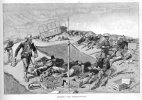Frederic Remington
Today, a fable of innocence and experience. The University of Houston's College of Engineering presents this series about the machines that make our civilization run, and the people whose ingenuity created them.
I finished high school in the Western logging town of Roseburg, Oregon. A couple of the older boys had summer jobs with the movies. They'd fall off horses for $5.00 a take. Next best to movies was riding in the rodeo. But the movement of Western horse and rider touched us all. We shared a deep-rooted vision of motion, masculinity, and rough-hewn grace.
No one did more to shape that shared vision than Frederic Remington. His sketches, paintings and wild kinetic bronzes still defined the West we knew in the late '40s. By now John Ford was building Remington tableaux into his Western movies. He openly copied Remington's composition and palette to gain realism.
Remington grew up on a diet of military glory. His father became a Civil War hero when he engaged his men in a foolish action that got most of them killed. Remington was 15 when Custer lay hold on the American imagination with his fiasco. In 1881, young Remington went West to find that kind of glory for himself.
He set out to be an artist and journalist. He learned his trade quickly. Then he went back to New York. He worked from sketches, photos and memory to create his West in oil and bronze.
He made more trips, of course. He chased after war. He hungered to see battle first hand. Meanwhile, he showed us action -- always right at the point of impact. A rider being thrown from his horse -- an Indian spear about to impale a pioneer.
Remington reflected all the racism and imperialism that was America in 1900. Yet his naivete saved him. He just missed the slaughter at Wounded Knee. He just missed other combat. He didn't find his live battle until the Spanish-American War.
What he finally saw in Cuba made him reel in horror. Stripped and mangled corpses stacked up while guns made quiet popping sounds in the near distance. There was no glory here.
It took Cuba to bring Remington to introspection. Not long before his death at only 48, his exhibits finally drew the critical praise he'd always craved but never had. He produced a series of quiet nocturnes -- night scenes of a gentler West.
But his action-packed West still defines the American sense of self. It's the Platonic ideal of a West that never quite was. Remington's West was born of naivete. It was a West that more objective eyes wouldn't've seen. A wise man once said, "Love is blind; and being blind sees less; and seeing less sees more."
Remington's blind side let him show us a West that was good and true, when the real West was morally flawed. Remington's naivete led him past the obvious folly, greed, and cruelty -- and let him show us the beauty of our dreams.
I'm John Lienhard, at the University of Houston, where we're interested in the way inventive minds work.
(Theme music)
Jussim, E., Frederic Remington, the Camera & the Old West. Fort Worth: Amon Carter Museum, 1983.
Splete, A.P. and Splete, M.D., Frederic Remington -- Selected Letters. New York: Abbeville Press, 1988.
Vorpahl, B.M., Frederic Remington and the West. Austin: The University of Texas Press, 1978.
For an astonishing array of sketches by 26 year old Remington, click on the picture gallery that follows Episode 1401.
For another of Remington's nocturnes click on The Herd Boy painted around 1905. (the Museum of Fine Art, Houston)
A short gallery of early Remington images of an Army encounter with Indians.
(Sumner, E. V., Besieged by the Utes. Century, October, 1891, pp. 837-847.
To see the full size image, click on the thumbnail above.





